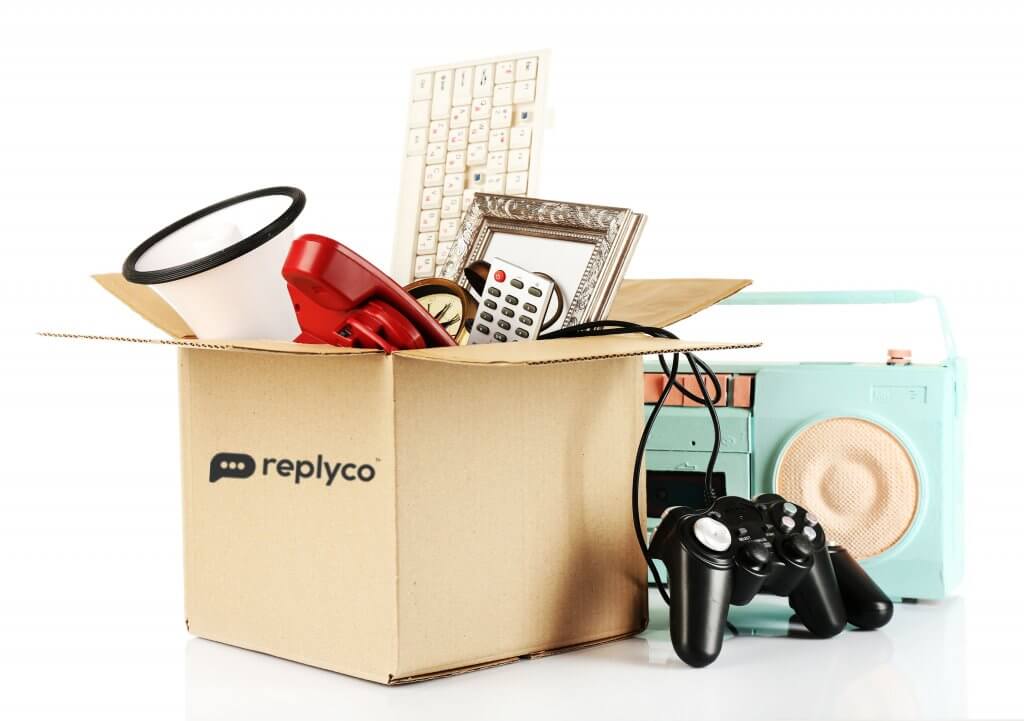Selling Used Items Online? 8 ReCommerce Tips to Maximize Sales

The experts at Replyco breakdown the best practices for selling used items online and gaining an edge in the competitive reCommerce market.
It’s no secret that buying and selling used or refurbished goods online is one of the most common activities on the web. In fact, reCommerce (the practice of selling used products online) has been around ever since the earliest phases of the internet. Believe it or not, the very first item sold on eBay was a used and broken laser pointer. While reCommerce has clearly been popular for decades, new technology and trends are driving growth in the used items marketplace more than ever before.
Why You Should Consider Entering the ReCommerce Market
According to CoreSight Research, reCommerce sellers are experiencing a 20x faster rate of growth than the retail market. Additionally, ThredUp’s 2020 Resale Report states that the secondhand market is expected “to hit $64B in the next 5 years” and “resale is expected to overtake the traditional thrift and donation segment by 2024.”
The surge in reCommerce activity can be attributed to new communication technologies, as well as the challenges of our modern world. The proliferation of mobile commerce and social selling on platforms like Facebook enables people around the world, with shared interests or hobbies, to network within online communities. This allows sellers to easily connect with niche, targeted audiences and sell their used items either directly through social media or through popular reCommerce sites like Poshmark, ThredUp and eBay.
Environmentally conscious shopping is another substantial reason for the renewed interest in used goods — a movement driven mostly by Generation Z and Millennials, who have a deeply vested interest in sustainability and the future wellbeing of the planet. According to ThredUp’s 2020 Resale Report mentioned above, appealing to a younger demographic and being environmentally conscious are two of the top three reasons why retail executives are interested in testing resale.
Whether you’re an individual looking to save money and space, an online store dealing with returned items or someone seeking to reduce their carbon footprint, there’s no better time than now to enter the reCommerce market. With that being said, here are our top tips to set yourself up for success when selling used items online.
Make Your Used Product Listings More Attractive
If the quality of your item listing demonstrates a lack of care or effort, why should prospective buyers care? Make your listing as attractive as possible by taking excellent photos, and lots of them. Research from Field Agent shows that “83% of U.S. mobile users consider product images to be ‘very’ and ‘extremely’ influential.” Moreover, a large-scale academic study proved that higher quality images are “more likely to generate sales” and are “perceived as more trustworthy.”
So what exactly can you do to take better used product photos?
Use Natural Light
Taking advantage of natural lighting is a time-tested best practice for eCommerce photography. One of its biggest benefits is it’s free for everyone. Barring a professional photography studio, natural light sets the stage for a much more aesthetically pleasing product photo shoot than the artificial lighting in your house — it’s also much easier for beginner photographers to work with. Start by setting your item alongside a window and take photos at various times throughout the day to get a feel for the optimal time for shadow and light balance. If the sun is too direct and creates harsh lighting, you could simply use a sheet or curtain to better diffuse the light.
Use a Camera or Phone Mount
Stabilizing your camera with a tripod or mount is a simple way to enhance the quality of your product photography. Your images are sure to come out sharper with much greater consistency and focus. And by using a mount, you’re much more likely to give more attention to framing your photo in order to get the perfect shot.
Pay Attention to Image Size and File Type
Providing prospective buyers with an optimal user experience guarantees that you won’t be losing sales due to factors unrelated to your product offering, such as slow load times.
According to Dynatrace, almost half of all consumers will abandon an eCommerce site after 3 seconds if it fails to load. So while you might be tempted to share the highest quality photos possible, try your best to keep your image file size no larger than 70kb. Additionally, JPEGs are generally recommended for your product pics, due to easy compression.
A final note on photos for reCommerce sellers is to check the image dimension guidelines for the eCommerce platforms you sell on. For example, while eBay requires a minimum of 500 x 500 pixels, uploading images that are 1600 px on their longest side allows for the best “zoom-in functionality,” providing an optimized user experience.
Write Compelling Product Descriptions
As an eCommerce copywriter for 5 years, I can tell you that crafting engaging product descriptions full of detail and useful information is vital for selling any product online. But, the argument could be made that this is even more important for reCommerce sellers who want to ease buyer anxiety. According to OneSpace, 87% of consumers consider the content within a product listing to be “very or extremely” important when deciding where to buy a product online. Let’s look at how you can begin writing better copy as a reCommerce seller.
Be Completely Transparent
When selling used items online, it might be tempting to leave certain details out of your product description. However, if there are only a few very minor scratches on a used smartphone, you should think twice before describing the phone as “good as new.”
Embellishing the product descriptions for your used items is a great way to lose business fast. Data from ReviewTracker reveals that “negative reviews have convinced 94 percent of consumers to avoid a business.”
Much better to be completely honest and describe when a product was bought, how much it was used and any imperfections it may have. Remember that most buyers don’t expect perfection from used products. Transparency goes a long way to establishing trust, reducing buyer hesitation and encouraging more repeat purchases in the future.
Describe Features and Benefits
Similar to selling new items online, you should write product copy that describes what prospective buyers are looking at (features), as well as why they should buy it (benefits). The difference between the two may seem semantic at first, but by including both in your product listing you ensure that customers will know exactly why they should buy your product. Communicating the return on investment that shoppers will receive from your used item is a great way to encourage potential buyers.
For example: “With 16 GB of RAM, this used 2019 MacBook Pro is essentially future-proof, and has all the multitasking power you need to get more work done in less time.”
For a complete breakdown of features and benefits, check out our guide here.
Make Your Listing Skimmable and User-Friendly
I’m sure we’ve all seen that one eBay product description — you know what i’m talking about — the one with 4 different text colors, h1 header font, all-caps and written in comic sans.
While that may be an exaggerated example, it doesn’t help you make a sale when your item listing features a wall of text with no spacing, formatting or lists. Be aware of the dwindling digital attention span we all suffer from in our modern world and write your copy accordingly.
However, this isn’t to say that you should forgo details and useful information for your audience in your listing. Rather, you should focus on formatting your content to make it skimmable and as user friendly as possible. To do this, use the following techniques:
Lists: Lists are one of the most practical ways to highlight the most attractive features and benefits of your product.
Links: Have a link to the user-guide of your used monitor? How about a sizing chart for your vintage denim jeans? Including useful links is a great way to call attention to particular elements in your listing. If possible, make sure your links open in a new tab so shoppers don’t leave your page.
White space: Break up your content with white space, whether it be between headers and body text, or lists and images. White space helps skimmers have an easier time identifying content of interest when scrolling down your listing.
Be Responsive to Customer Inquiries
While responsiveness is crucial for any eCommerce business, reCommerce sellers will likely receive even more inquiries about their product offerings than those selling new products. That’s because, even though the resale market is trending towards a greater level of normalcy, many shoppers still feel trepidation when it comes to buying something that isn’t brand-new and in a box with a manufacturer’s warranty.
This fact, along with an unprecedented level of eCommerce competition, means that if you take a couple days to get back to a shopper, chances are that they have already gone somewhere else for their purchase. New research from SuperOffice states that “88% of customers expect a response” within 60 minutes. Suffice to say, if you want to compete with bigger reCommerce vendors, you should definitely focus on reducing your response time. Here are a few methods to do just that.
Anticipate Customers’ Information Needs
One way to increase response rate is to prepare for the questions most likely to come your way. Selling a TV? Have a list of technical specifications that aren’t already included in your listing ready to go. There’s a good chance someone will ask you a question about contrast ratio, backlight lifespan or mounting capabilities, so make sure to have the extra details about your product easily accessible. If you’re selling vintage clothing, expect questions about sizing or washing instructions.
Be Reachable in More Places than One
Use social media to augment your resale operations. A customer in a rush for a last-minute gift might seek out a response immediately. By enabling contact through Facebook Messenger or other instant messaging systems, you can drastically reduce response times and increase customer satisfaction.
Organize your Customer Communications
If you’re selling on more platforms than one, a cluttered inbox and a high volume of shopper inquiries can interfere with your ability to quickly connect with customers and provide them with helpful information. With Replyco, you can easily manage messages from a growing list of eCommerce marketplaces. Reply to all of your customers in one inbox that makes use of user-friendly filters for easy navigation as well as custom email templates and autoresponders to improve efficiency and take the stress out of selling online.
Industry experts agree that the resale market will continue to expand globally for the foreseeable future. Every day, more people are beginning to change their spending habits and take ownership over their role in creating a sustainable future. By all means, the surge in reCommerce shopping is a positive trend that helps create a better quality of life for everyone involved. Sellers benefit from making more sales while buyers enjoy a discounted price and the satisfaction of finding a great deal. Hopefully this article helped you implement some best practices for selling used items online to maximize your sales.





